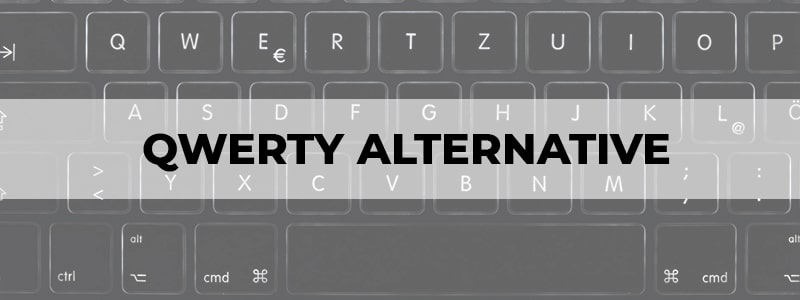
QWERTY keyboard first appeared in 1873 when its inventor, Christopher Latham Sholes sold it to the Remington Typewriter company.
This company made some minor modifications in the basic layout of the QWERTY keyboard to turn it into the keyboard layout used all over the world today.
The idea behind the QWERTY keyboard layout was to space out the most often used keys to avoid their jamming, making it efficient for the users.
Nonetheless, some other keyboard layout alternatives might fulfill your need better than QWERTY, whether it is work, gaming, or anything else.
Below you’ll find a detailed list of them. So, let’s begin!
Best QWERTY Keyboard Alternatives
Dvorak
Named after its inventor August Dvorak, Dvorak is the most well-known keyboard layout out there after QWERTY.
The main feature of Dvorak that sets it apart from QWERTY is that it has the most frequently used keys on the home row. This explains why an average user of Dvorak makes 70 percent of keystrokes in the home row, compared to only 32 percent by a QWERTY User.
Moreover, since the majority of the world’s population is right-handed, you’ll find the most often used keys on the left side on a Dvorak Keyboard.
Colemak
Colemak is another one of the famous keyboard layout options available besides QWERTY.
The idea behind this Shai Coleman’s creation in 2006 was to ensure that the strongest fingers of humans press the most often used keys.
There is only a difference of 17 keys in the Colemak keyboard layout and the QWERTY keyboard layout, meaning that if you’re a QWERTY user who’s in search of a more comfortable and user-friendly keyboard layout, then Colemak is your choice.
Maltron
When it comes to unique keyboard layouts, then Lillian Malt’s invention, Maltron undoubtedly tops off the list.
With a number pad in the middle and two squared sets of letters on either side, the Maltron keyboard can be extremely convenient, especially if you need a keyboard for your workplace.
AZERTY
Used mostly in French-speaking countries of both Europe and Africa, there are some major differences between the AZERTY Keyboard and the QWERTY Keyboard Layout.
The first difference that is quite apparent by the name, AZERTY is that Q is replaced with A and W is replaced with Z. In addition to this, the semi-colon’s key in QWERTY is replaced with the letter M in AZERTY.
Other than that, in AZERTY, the functionality of the row of numbers and symbols is opposite to that in QWERTY.
QWERTZ
As indicated by its name, the QWERTZ Keyboard Layout is quite similar to the QWERTY Keyboard Layout, with the only major difference being the shuffling of the Z and Y letter keys.
This difference is mainly due to QWERTZ being commonly used in German-speaking countries like Germany and Austria.
In German, Z is more repeatedly used than Y. Likewise, T and Y are usually adjacent in German Orthography, meaning that the German Typing with this layout will be more effective.
JCUKEN
Used mainly in Russia, JCUKEN – formerly known as JIUKEN, is a Cyrillic Keyboard Layout.
The update in the name of this keyboard layout came in 1917 when the Russian alphabets were reformed.
QWDFGY
QWDFGY is another alternative Keyboard Layout for QWERTY.
Most of the keys in QWDFGY are in their QWERTY positions and even the replaced keys are close to their old positions. It means that the QWERTY Users won’t have a hard time adjusting to this keyboard layout.
NEO
Optimized primarily for programmers, this keyboard layout offers you some very special programming-related symbols and letters that you won’t find on any other keyboard layout.
Although this keyboard layout focuses on German-speaking users, you will also be able to type the English words commonly associated with German quite efficiently.
QWPRFY
There are 11 keys in QWPRFY that are different from QWERTY. However, except for P and Y, you’ll be using the same fingers to press them.
The standout feature of this keyboard layout and the one that makes it helpful for programmers is that by pressing its caps lock, you can conveniently access punctuation and arrow keys.
QGMLWY
The QGMLWY keyboard prioritizes a smooth typing experience. Its layout is useful not only for English but also for Latin languages.
The vowels and consonants are separated onto two different sides and since most of the Latin words are a combination of vowels and consonants, there is minimum jamming while typing the Latin words.
Norman
Compared to QWERTY, only four of the letters of Norman are moved, making it one of your top preferences to transition from QWERTY.
Just like Dvorak, Norman has its most frequently used keys towards the right, thus favoring the right-handed users.
Additionally, over 50% of Norman’s keystrokes are in the home row, explaining why it is considered a fast and comfortable keyboard layout.
Conclusion
All things considered, whether you want to change your keyboard layout from QWERTY or not, is completely up to you.
If the QWERTY layout is not supportive of the nature of your work or you’re just looking for a change, then consider shifting to a different keyboard layout.
However, at first, try out a keyboard layout similar to QWERTY so that you have an easy time getting the hang of it!
